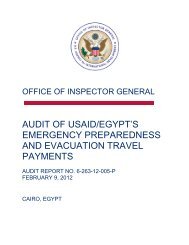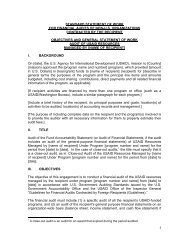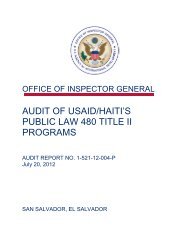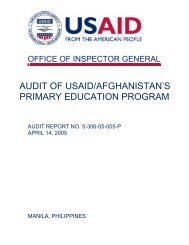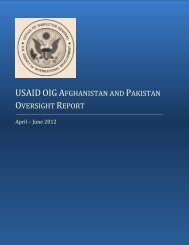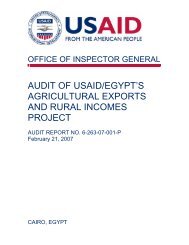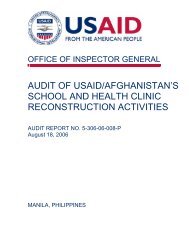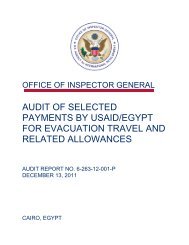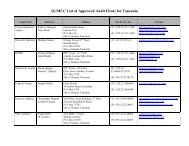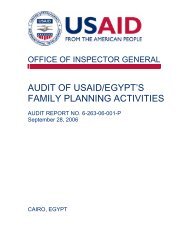Audit of USAID's Haiti Recovery Initiative Activities MAnaged by ...
Audit of USAID's Haiti Recovery Initiative Activities MAnaged by ...
Audit of USAID's Haiti Recovery Initiative Activities MAnaged by ...
You also want an ePaper? Increase the reach of your titles
YUMPU automatically turns print PDFs into web optimized ePapers that Google loves.
Environmental Review Not Performedand Approved Before ImplementationADS Chapter 204, “Environmental Procedures,” states that USAID must fully comply withenvironmental procedures established in the Code <strong>of</strong> Federal Regulations (22 CFR 216).USAID is required to “integrate environmental issues into its programs, both to meet U.S.Government legal environmental obligations and to optimize economic and social developmentresults.”Supplementary guidance to ADS 204 provides descriptions <strong>of</strong> environmental procedures toinclude in requests for proposals and award documents. The purpose is to give USAID time toconduct environmental reviews and incorporate environmental factors and mitigating measuresin the design and approval <strong>of</strong> each program and activity before making an irreversiblecommitment <strong>of</strong> resources. ADS further states that the review should be done as early aspossible in the design process to allow enough time for more detailed subsequentenvironmental review and concurrence, and for integrating environmental mitigations into theprocess.Chemonics has established procedures for environmental reviews to screen each activity forpotential adverse impacts, recommend determinations to categorize environmental risk, andidentify mitigation and monitoring measures. The procedures for mitigation and monitoringinclude templates for environmental mitigation plans and reports; these were developed forUSAID/<strong>Haiti</strong> to use when implementing infrastructure and related activities.Several <strong>of</strong> the activities the team reviewed were designated as “negative with conditions,” whichapplies to activities that could have moderate adverse environmental impacts, but could bemanaged effectively with appropriate mitigation and monitoring measures. For these activities,Chemonics used plans that included mitigation measures and reporting on monitoring <strong>of</strong> thosemeasures.In one <strong>of</strong> the activities, OTI did not complete the required environmental review and mitigationand monitoring plan before implementing the activity, which was designed in June 2011 togenerate temporary employment opportunities through planting 700,000 jatropha 2 seedlings inthe Saint-Marc corridor. In Chemonics’s environmental review <strong>of</strong> the activity, it recommended adetermination <strong>of</strong> “negative with conditions,” requiring an environmental mitigation andmonitoring plan.However, although the seedlings were planted in August 2011, OTI had not approved theenvironmental determination, and the mitigation and monitoring plan was not in effect. Theenvironmental <strong>of</strong>ficer visited the jatropha plantation in August 2011 and said that no negativeeffects had occurred; the <strong>of</strong>ficer said Chemonics had done scientific research to be sure that thetype <strong>of</strong> jatropha was proper for the area, but had not yet documented the environmental workperformed. Subsequently, Chemonics developed a mitigation and monitoring plan andsubmitted it to USAID/<strong>Haiti</strong> and OTI for approval. The mission environmental <strong>of</strong>ficer andcontracting <strong>of</strong>ficer’s representative approved the environmental mitigation plan and report inOctober and November 2011, respectively—after the jatropha had already been planted.2Jatropha curcas is a species <strong>of</strong> flowering plant cultivated in tropical and subtropical regions.8



